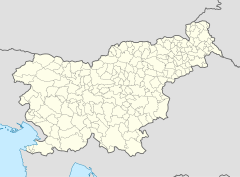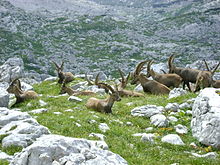Triglav National Park
| Triglav National Park | ||
|---|---|---|
| The Triglav , Slovenia's highest peak | ||
|
|
||
| Location: | Slovenia | |
| Surface: | 838.07 km² | |
| Founding: | 1924/1981 | |
| Address: | www.tnp.si | |
The Triglav National Park ( Slovenian : Triglavski narodni park ) is the only national park in Slovenia .
location
The park is located in the Julian Alps , in northwestern Slovenia, on the border with Italy and Austria , and has a size of 83,807 hectares (838 km²).
history
In 1908 it was proposed for the first time to protect the Triglav region more sustainably. In 1924, a 1,400 hectare valley was designated as an “Alpine Protection Park”, which was enlarged a little in 1961 and was given the name National Park. The national park has existed in its current size and shape since 1981. In the core area of today's national park, the provisions of nature conservation are strictly monitored.
There are 7,000 km of marked and regularly maintained paths in the park with inns and shelters.
The National Park

The national park is named after the highest mountain in Slovenia at 2864 m, Triglav , which is almost in the center of the park. There are numerous glacial lakes in the national park, limestone dominates the rock types. Of particular note are - in addition to the high alpine region - the valleys of Soca and Sava Bohinjka with the Lake Bohinj (Bohinj), the largest permanent lake in Slovenia, which were able to maintain a very original landscape and architecture, as well as the wooded plateaus Pokljuka and Mežakla.
The best- known legend of the Triglav National Park is the Zlatorog , a chamois with golden horns. There is a legend that has been handed down in various versions around him, in which love and betrayal, greed and destruction are always the themes. The legends were collected by the Thuringian botanist and poet, Rudolf Baumbach , to whom many writers in this region, u. a. Julius Kugy , emulated. Statues of the golden horn can be found at Lake Jasna near Kranjska Gora and at Lake Bohinj .
fauna
The fauna of the national park is rich in species. In addition to the usual alpine wild animals such as ibex , chamois , red deer and capercaillie , brown bears occasionally roam the area, and lynxes also live there.
The golden eagle is visible in the air . The sand viper and the adder are worth mentioning as venomous snakes . Of the numerous endemic species, the marble trout , which occurs in the Soča and some other tributaries of the Adriatic and is still threatened by the brown trout released during the Second World War, deserves special mention.
flora
The flora of the national park is also important. Numerous endemic plant species caused a stir among botanists as early as the 18th century. Well-known in the Triglav National Park are the (violet) Zois bellflower , the red Dolomite cinquefoil as well as the yellow Julian poppy and the alpine edelweiss . In the higher elevations from 2000 m under cover of grow -flops as Almrausch known hairy alpenrose and the Dwarf Alpenrose ( heather plants ).
tourism
For the area of the national park, which is criss-crossed by a network of uniformly marked mountain trails, mountaineering, for example on the Svinjak , is significant for tourism . The Slovenian Alpine Club has 32 houses and huts here. Besides, this is whitewater kayaking significant. The Soča and Koritnica rivers are a magnet for water sports enthusiasts, among other things because of some challenging white water stretches .
The villages of Kranjska Gora , Bled , Kobarid and Bovec, listed clockwise from the north, are particularly suitable starting points for exploring the interior of the national park .
The Vintgar Gorge
literature
- Karl Baedeker : Slovenia , Verlag Karl Baedeker, ISBN 978-3-8297-1268-2





